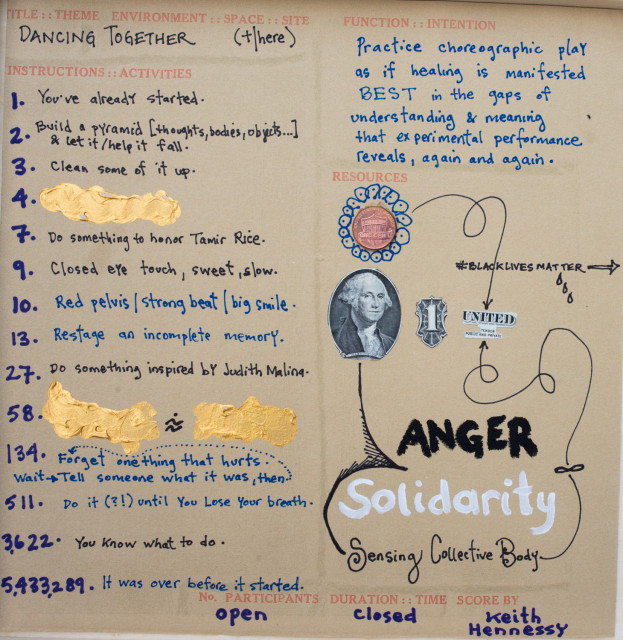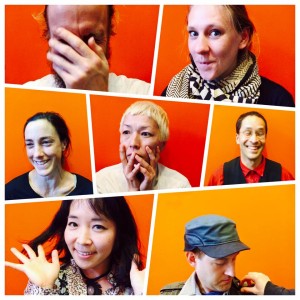“…How am I even going to write about this emerging, unfolding thing?…”
I wrote this after my first day observing theater and dance company inkBoat in rehearsal for 95 Rituals, a work that is being created in honor of artist Anna Halprin’s 95th birthday in July. Some of the rituals have already happened, some are in the works and many are upcoming. I entered as an observer somewhere after ritual 6 in order to write about inkBoat’s process. As I observe the inner workings of 95 Rituals, two questions keep coming up for me: how do I reflect in words the still ongoing artistic process that inkBoat is engaged in, and how do I witness inkBoat’s process in an embodied way, feeling their actions and activities rather than remaining objective? What follows is my desire to literally flesh out my field notes, allowing my embodied experience of inkBoat’s rehearsals to mingle with key details guiding the creative process of 95 Rituals thus far. I hope to reflect in writing the haptic, unfinished quality of inkBoat’s process as I experienced it during rehearsals for Ritual 8-27: market, a series of rituals presented at the farmer’s market at Fort Mason Center on May 31, 2015, and as I will continue to experience the work in the coming weeks.
DAY 1
“…invited spy’ outside observer…”
Shinichi Iova-Koga, director of inkBoat’s involvement in 95 Rituals dubs me an “invited spy.” This implies that I will be doing some sort of permissible witnessing while attempting to go un-detected. I feel like an outside observer, sitting at the edge of the group of artists, looking in.
“…WARM UP (write me : ) )…”
My anxieties about being a purely objective observer are assuaged when the company invites me to participate in their warm-up. It is foolish of me to think I can avoid bringing my body to bear on the experience of witnessing. I remember Dwight Conquergood’s piece, “Rethinking Ethnography: Towards a Critical Cultural Politics” in which he calls for a return of the body in ethnographic research, describing ethnography as an “embodied practice.” He says, “recognition of the bodily nature of fieldwork privileges the processes of communication that constitute the ‘doing’ of ethnography: speaking, listening, and acting together.” (2-3, Conquergood) I do not end up writing about the warm-up but the smiley face in my notes indicates how I felt in the moment: touched to be invited to participate physically. The smiley face also marks when I realize I will be more participant than observer as I write about inkBoat’s artistic process.
“…Scores. brown card stock w/ instructions sent out to people. Sent back…”

Shinichi has a box full of brown card stock that detail scores he has received from the community designed to pay tribute to Anna. Within 95 Rituals, a “score” is a word deriving from Anna and Lawrence Halprin’s RSVP cycle. The RSVP cycle is an open sourced recipe for making artistic work; following the cycle, artists use (R) Resources to create (S) Scores (which involve some number of people, doing activities, in a place, for an amount of time), which are then assessed according to (V) Value-action, a form of reflective feedback, and then put out into the world as (P) Performance. The sequence of the cycle can be rearranged and recycled, allowing the artist to attend to their creative process rather than focusing solely on creating an artistic outcome. Focus on process rather than outcome is why this box of scores in Shinichi’s hands exists. Blank “scores” were sent out to 95 artists. The scores prompt the artists to describe the details of a ritual intended to be performed for Anna. The returned scores [like the two scores by Keith Hennessy and Janine Antoni] are full of lyrics, drawings, cut-up money, glitter, and recipes. Some are torn and some are pristine. These scores are raw, material, (R) resource, to launch the artists into their process of creating rituals.
DAY 2
“…warm-up— arm connection center, not in unison but connecting… For Anna not about Anna…”
We do an exercise where one person’s bodily center is connected to the bodily center of every-one else in the group. We move, responding to this imaginary line connecting our centers to the chosen person’s center. Questions that come up include: How is my center “supposed” to respond to another person’s center? Can I be connected to another person’s center without imitating them? These questions return later when the group talks about how Anna and her work are influencing 95 Rituals. 95 Rituals is for Anna, not about Anna. The goal of the work is not to imitate Anna or her past works but, like the exercise, to experiment with the various different ways of “connecting” to Anna as a center point of focus.
“…HOW to choose. WHAT is chosen. WHAT is the overall uber-score created for this?…”
With all these “scores” as raw material, how do decisions get made? Who chooses which scores will grow into one of the rituals? How do all 95 scores fit together? Power circulates freely within the group, which means artists share the work of decision-making, directing, and performing. There is not a singular “who,” “what” or “how” guiding the work, rather the “whos,” “hows” and “whats” emerge through collaboration between the artists. Shinichi Iova-Koga, as the named director of 95 Rituals acts as both performer and curatorial outside-eye, ensuring that the rituals come to fruition in time for their scheduled performances.

“…Score Seam…Circling Benches….Bowing Outside”
Experimenting with one of the 95 scores, composer Joshua Kohl directs a solo for one of the many inkBoat artists, Dohee Lee, called “Seam.” The score instructs participants to find the seams of an environment with their body and it is set to a piece of music by Mozart. The score proceeds: Dohee peels herself off the surface of a bench, stood upright on its end. She slowly sinks to lie horizontally on another bench turned on its side. She slides off the bench, now behind it. Dohee’s arm and stray lock of hair remain, embracing the bench. We as audience members are quiet, moved by the imagery. Joshua reads the lyrics of the song—it’s about life moving into death—and Dohee has tears in her eyes explaining how the lyrics moved her. The breathing in the group changes; a few other eyes are now wet. It isn’t stated, but it feels like this score is a keeper.
5-21-15
“… ritual-legacy, time-space, purpose-intention…”
Ritual 7: words happens at the Museum of Performance + Design. The ritual consists of a conversation between Anna and Shinichi, introduced by Janice Ross and moderated by Ellen Sebastian-Chang. Sebastian-Chang describes ritual and its connection to dance and Anna. In contrast to habit, ritual is our intentional consciousness of time and space. Dancers and choreographers inevitably work with ritual because of how dance implies a focus on time and space in relation to movement. Anna’s choreography is significant in part because of how she turns dance’s ritualistic attention to time and space back on everyday life, connecting choreography less to a specialized skill set as much to a way of being attentive to the world around you.
Friday @ the Firehouse
“…Ritual (acc. to E.S-C. @ talk) refers to consciousness to time + space”
Sebastian-Chang’s notion of “ritual” comes up during inkBoat’s rehearsal for their site-specific piece at the Fort Mason Center’s farmer’s market. In creating a site-specific piece, the artists are not transplanting a pre-fabricated piece into a place. They are creating a piece connected to the site, attending to the specificities of time and space within it. The specificities of the site include its visual architecture and landscape, its history, the different feelings it inspires and the people in the space. Finding the boundaries of this site then is difficult because the site is constantly in flux, its physical shoreline never constant, different people coming and going. To engage with the site means the artists and I try to touch its boundaries, finding its literal and conceptual edges. We climb as high as we can, wander as far away as seems appropriate, see what feelings arise, find where sound is alive or dead…
Sunday I Think
“… No central nugget, no punctuated “.”, no linear trajectory—a wobbly walk towards July 13.”
I stop taking field notes after I write this; the very act of note-taking feels like an attempt to conclusively pin down the artists’ process. inkBoat’s process is far from conclusive; the more time I spend with the artists, the more their process unfurls, emerges, and doubles back on itself, avoiding any sense of finality. This elusive quality is apparent during experiments at Fort Mason’s farmer’s market.

I act as a witness while the artists experiment with possible farmer’s market scores. Two of inkBoat’s international artists, Yuko Kaseki and Heekyung Cho dance to the live music of a guitarist. Yuko grabs my hands out of my pockets to dance with her and it is like I have forgotten how; being pulled in to participate has suddenly unmoored me from my physical, “dancer-ly” sense of self. Dana Iova-Koga and Crow Nishimura, more inkBoat collaborator/performers, stand at the top of two fire escapes dancing to, for, and with each other. Two girls gaze up at them, dancing and swaying along. Dohee moves through the crowd holdingup her hand. Someone offers her a high five, and suddenly she is off, rushing through the crowd and high-five-ing everyone. This last experiment is repeated: now all the artists will try soliciting high-fives. Dana steps out. Yuko and Heekyung return to the guitar music. The artists’ participation in the high-five experiment dwindles naturally.
We gather to converse about this experiment but no one can hear over the din of music and farmer’s market noise; the discussion about how to interact with the farmer’s market site is overwhelmed by the chaos of the site itself. The conversation moves to the enclosed firehouse space at Fort Mason. Everyone tosses around ideas but no final decision is reached about what action, if any, will take place in the farmer’s market. In this state of indecision the group moves on to their next site to experiment anew.
Notes to self:
“…mutual giving”
“…observe-participate”
“…bring food to share”
The inkBoat artists hug, joke, share their food and look for ways to invite audience participation. I felt this day one when Dohee shared her dumplings with the group and at the farmer’s market when Yuko grabbed my hands to dance. inkBoat graciously welcomes in the people and world around them and as a result 95 Rituals does not feel like a project closed off from outside influence. Instead, 95 Rituals, in both process and performance, feels more like an invitation, welcoming artists and audience alike to join the fun and celebrate Anna Halprin.
This article appeared in the July/August 2015 issue of In Dance.


